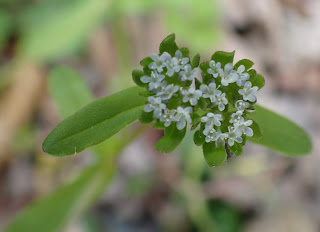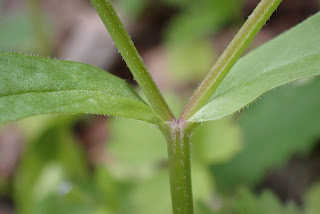All these plants are found in local lanes and woodland.
Three-nerved Sandwort, Moehringia trinervia
Harrap's Wild Flowers says this member of the Chickweed family is locally common on shady hedgebanks and that is exactly where I spotted it on higher ground in the Wye Valley. The ivy leaf shows the scale of this tiny flower. The key ID features for me are the unsplit petals that are shorter than the sepals and the leaves with prominent 3-5 parallel veins. This example has one missing petal, of course.
Commonly grown in gardens this one is naturalised in a hedgerow. It had been introduced from Southern Europe in 1375 and was recorded in the wild by 1805. It is tall and upright with arrow shaped leaves all the way up the stem. The flowers are large, fragrant and in this plant deep pink. They range from white to deep purple.
Foxglove, Digitalis purpurea
Native Foxglove, a member of the Veronicaceae family, has a long folk history. Grigson in The Englishman's Flora is again my source. To me some of the local names he gives are very visual. Bee-catchers, for example, a Somerset name, will resonate with anyone who has watched bees disappear inside them. There are many names concerned with fairies: Fairy Fingers is again a Somerset name. As a reaction to this and the belief that fairies, or even goblins, could use the Foxglove for or against you came names with a religious connotation: Lady's Glove, Lady's Fingers and Virgin's Fingers. A name was needed for botanists and apothecaries and Digitalis was coined in 1542 from a German name for thimble.
William Withering worked on the plant in 1785 and proved it was a good diuretic and acted on the heart but the limited science of the time could not establish why. Later science turned the source of old remedies into a major drug.
The flower is so familiar and distinctive it scarcely needs description. The flowers pinkish -purple or white, spotted darker within the throat guard sentinel-like many a woodland walk around here in the Wye Valley.
This completes another week of #365Days of Botany. I hope to post again midweek.



















































